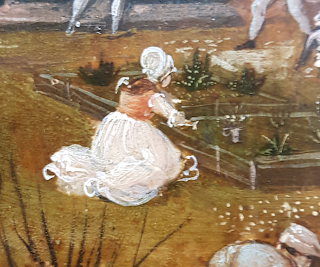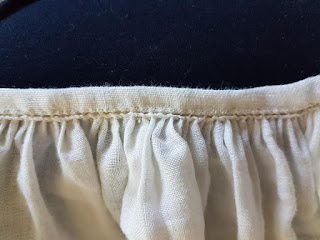According to Zanders-Seidel this developed during the 16th century into the waist-surrounding apron, without the upper part, looking almost like a second skirt. Like this one in one of Hans Wertingers paintings The Labors of the month from 1525.
Here is another one from the same set of paintings.
In everyday life an apron covering the whole skirt, a washable layer over a usually not washable dress, most have been effectiv and helpfull. This type where used of both peasant and patrician women. I have not seen it in any woodcuts of woman of the landsknechttross though. Edit: just found one! (21 june). The woodcut is made by Jacob Vinck and is of a soldier and a woman. Its an apron of this kind, with a pleated waistline.
In the painting Pyramus and Thisbe by Hans Baldung we can see another apron of this kind. This one has a decorative seam, possibly drawn threadwork, at the hemline and what I think is a smock at the waist.
I desided to make mine in white linen, with some decorations. According to the clothing directories in Germany the aprons where predominantly made of linen fabrics, linen/cotton or wool. In England a common fabric for working aprons was durance, a very close wollen weave, making it a safe choice when working over open fire. The colours on aprons in Germany where almost invariably limited to white, red and black, according to inventories. But in paintings we can also see green ones, embroidered ones, and with fur linings or with stripes.
I made mine with drawn threadwork at the hemline and a decorative row of stay-stiches at the waistline. I saw that on the sleeve-ends of the white linen shirt worn by Nils Sture, now in the museum of the Uppsala cathedral, from 1567. There is also a lot of pictures of it in Patterns of Fashion 4, by Janet Arnold. I used waxed linen thread and all the seams are felled and whip stitched.
The drawn threadwork at the hemline is made like this. The hemline is 330 cm.
I started with basting stitches to make the gathers.
All the gathers at the waistline are held in place on the outside, as a decoration, by a single line of stitching.
Then I added the waistband with whip stitches.
And this is how it turned out!
If I make an apron like this again I would make it longer, its clearly to short for me. A bit like the one in Hans Baldungs painting but still to short.
This is me at an event in may when I just started sewing on the apron.
Literature:
Patterns of Fashion 4
Textilier Hausrat
The Tudor Tailor




















